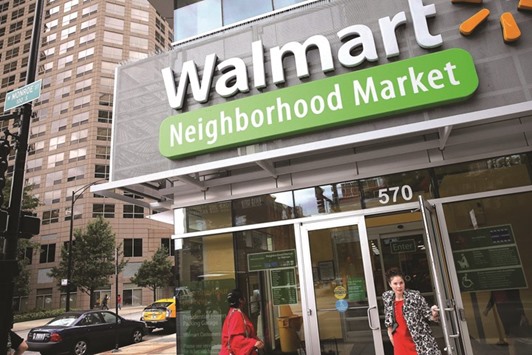Walmart Stores and its peers are putting a little more money in the pockets of some of their biggest customers: their own employees.
Since the start of this year, 14 US states and several cities have increased their minimum wages, handing at least 2.8mn workers’ pay increases that could be worth thousands of dollars a year. Some companies, like Walmart, didn’t wait for statutory orders: the retail giant is set to hand out $1.5bn in pay rises this month.
One question is how much will trickle back to Walmart itself, and the other companies handing out more cash to their low-wage workforce. Economists and analysts say the answer isn’t entirely clear. But some investors are betting that more spending power at the low end of the economy could be good news for discount retailers, whose shares are outperforming a bearish stock market.
“The dollar stores, Walmart, Target, they benefit more directly and dramatically,” said Harley Shaiken, a professor at University of California, Berkeley who studies labour issues and supports minimum wage increases. “At the low end of the wage market, people are scraping by. They get more money, they spend it.”
After stumbling initially on news of the pay rises, Walmart has been the second-biggest gainer on a plunging Dow Jones Industrial Average this year, rising 7.5%. The company is due to report fourth-quarter earnings today. Some smaller discounters are doing even better: Burlington Stores and Ollie’s Bargain Outlet Holdings are up 27% and 25% respectively.
Those companies are well placed to attract some of the extra money in American pockets. While wage growth has generally been lacklustre since the financial crisis, in the five months through January hourly earnings rose at an average annual pace of about 2.5%. That’s the best run since 2009, and Labor Secretary Thomas Perez says minimum-wage rises are helping to drive it. The low-cost stores also stand to benefit if the economy slows and middle-income shoppers start hunting around for better deals.
Other businesses beyond retail are also expecting to see more spending. Rent-A-Center leases furniture and appliances to consumers who can’t get credit, and chief financial officer Guy Constant said the company should be a net winner from rising wages, despite the added costs.
“Our customers are those minimum wage earners or close to minimum wage earners that are all going to be seeing salary increases which will allow them to shop in our stores,” Constant said on an October conference call with analysts. In some regions “we will have to pay a little bit more, but on balance rising minimum wages is a good thing for our business, not a bad thing.”
The auto industry has been a big winner from past minimum wage hikes, as the added income enabled workers to save up for a down payment or qualify for a loan, according to a study by economists at the Federal Reserve Bank of Chicago that looked at data from the 1980s to 2008. Higher spending on transportation is one of the biggest differences in spending between households making between $20,000 to $30,000 a year, and those in a slightly lower bracket whose earnings are roughly equal to those of one full-time minimum-wage worker.
The extra income “could in theory help a buyer more easily qualify for a loan,” though dealers aren’t counting on it, said Larry Laskowski, executive director of the Independent Automobile Dealers Association of California. “Time will tell.” He said that in the short term, more of the minimum-wage gains might get spent on auto repairs.
Angie Godoy, who works part-time as a cashier at a Los Angeles McDonald’s while going to a local college, said most of the extra $200 a month she has earned since the city raised its minimum wage to $10 an hour on January 1 has gone on school supplies, tuition, and to help her mom. But she hopes to eventually use it to save up for a car. Now, she either has to take a bus or walk 90 minutes to work when she can’t afford a bus pass.
“I’m trying to save for a car, but it is hard,” said Godoy, who has joined protests demanding a $15 minimum wage. “A car would help me help my mom more. It is very hard because I have to get home and cook for my brother or sister or go to the market. If there was an emergency or something, I don’t know how I’d even get to the hospital.”
In the past, the credit cycle amplified extra spending by low earners who got a raise: they’d borrow to make big-ticket purchases. While a $1 increase in the hourly minimum wage would generate $250 in extra income per quarter for households, their spending would rise by $700 a quarter, according to the Chicago Fed study.
That may have changed after the Great Recession: households have been deleveraging after a decades-long run-up in debt.
But minimum-wage earners are still more likely than other Americans to spend any extra dollars they get, said Wallace Hopp, a business professor at the University of Michigan.
“Increasing the minimum wage puts more money in the pockets of precisely those people who spend it the fastest,” Hopp said.

Wallmart is set to hand out $1.5bn in pay rises this month.


